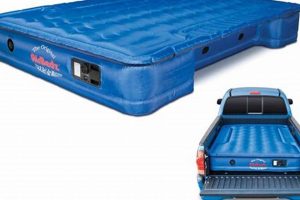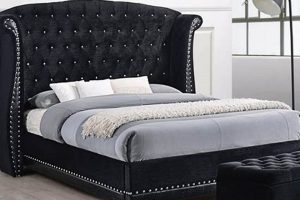Suitable coverings designed for beds with shallow depths are essential for proper fit and comfort. These specialized linens address the common issue of excess fabric when standard-sized sheets are used on mattresses lacking substantial thickness. An example would be using sheets tailored for an 8-inch deep mattress on a bed with only a 5-inch depth.
The utilization of appropriately sized bedding contributes to a neater, more aesthetically pleasing bedroom environment. Furthermore, it enhances sleep quality by minimizing bunching and wrinkling, which can cause discomfort during the night. Historically, options were limited, leading to improvised solutions. However, increasing demand has spurred manufacturers to offer a wider range of options in various materials and thread counts.
The subsequent sections will delve into material selection, sizing considerations, and practical advice for choosing the optimal bedding solution. Detailed comparisons of different fabric types, along with a guide to measuring mattress depth accurately, will equip consumers with the knowledge needed to make informed purchasing decisions.
Tips for Selecting Bedding for Shallow Mattresses
Proper selection of linens for shallow mattresses enhances comfort and ensures a well-maintained sleeping environment. The following guidelines facilitate informed decision-making.
Tip 1: Measure Mattress Depth Accurately: Obtain precise measurements of the mattress depth before purchase. Inaccurate assessments lead to ill-fitting sheets.
Tip 2: Prioritize Fitted Sheet Pocket Depth: Select fitted sheets with pocket depths closely matching the measured mattress depth. Excessively deep pockets result in slack fabric.
Tip 3: Consider Material Properties: Evaluate different fabric types, considering breathability, softness, and durability. Cotton, linen, and microfiber offer varying characteristics.
Tip 4: Opt for Elastic Band Security: Ensure the fitted sheet has a robust elastic band that encompasses the entire perimeter. This secures the sheet and prevents slippage.
Tip 5: Evaluate Thread Count Realistically: High thread count does not automatically equate to superior quality. Focus on fiber quality and weave construction instead.
Tip 6: Pre-Wash Before First Use: Laundering the bedding prior to initial use softens the fabric and removes any manufacturing residues.
Tip 7: Inspect Stitching Quality: Examine the seams for tight, even stitching. Weak seams are susceptible to tearing and premature wear.
Adhering to these tips ensures the selection of bedding that fits correctly, provides optimal comfort, and withstands regular use, maximizing longevity.
The article will conclude with a summary of the critical considerations for maintaining the selected bedding, extending its lifespan and preserving its quality.
1. Accurate depth measurement
The correspondence between accurate depth measurement and suitable bedding for shallow mattresses is direct and fundamental. Inaccurate measurements are a primary cause of ill-fitting sheets, leading to discomfort and reduced sleep quality. If the mattress depth is underestimated, the fitted sheet will lack sufficient material to securely cover the bed, resulting in slippage and bunching. Conversely, overestimating the depth results in excess fabric, creating wrinkles and potential entanglement during sleep. For example, a mattress measuring 6 inches in depth requires sheets designed for that specific dimension; using standard sheets intended for a 12-inch mattress would create significant problems. Understanding the precise depth is, therefore, an indispensable initial step in the selection process.
The practical application of accurate measurement extends beyond initial purchase. It informs laundering practices, preventing premature wear caused by improper folding or storage of excessively large sheets. Furthermore, precise dimensions assist in comparing specifications across different sheet manufacturers, enabling informed decisions based on a standardized understanding of size. Consider the scenario of purchasing bedding online; without accurate measurements, reliance on generic size labels leads to inconsistent results. Verifying dimensions, however, assures compatibility with the intended mattress.
In summary, accurate depth measurement is not merely a preliminary step but a crucial component in achieving optimal bedding fit and comfort. Addressing measurement errors through precise assessment mitigates many issues associated with ill-fitting sheets. The ability to effectively measure and interpret mattress depth guarantees the selection of sheets that conform appropriately, ultimately contributing to a more restful sleep experience. The challenge lies in consistently applying these measurement practices across all bedding purchases, prioritizing precision over generalized size assumptions.
2. Pocket depth selection
The selection of appropriate pocket depth in bedding is paramount when addressing sheets specifically designed for shallow mattresses. It directly influences the fit, comfort, and longevity of the sheets, mitigating common issues associated with standard-sized bedding on thinner mattresses.
- Minimizing Excess Fabric
Sheets with excessively deep pockets, when used on shallow mattresses, result in surplus material that bunches and wrinkles. This not only creates an unkempt appearance but also compromises sleeping comfort. Appropriately sized pockets eliminate this excess, ensuring a smooth and taut surface. For example, standard sheets with 15-inch pockets applied to a 6-inch mattress will inevitably lead to discomfort and require constant readjustment.
- Ensuring Secure Fit
Conversely, insufficient pocket depth prevents the fitted sheet from securely attaching to the mattress corners. This results in the sheet slipping off during the night, necessitating frequent remaking of the bed. Sheets with appropriately selected pocket depths anchor firmly, preventing slippage and maintaining a neat appearance. A pocket depth only slightly smaller than the mattress height increases tension and the likelihood of popping off the corners.
- Extending Sheet Lifespan
Ill-fitting sheets experience increased stress at the corners and along the elastic seams. This heightened tension accelerates wear and tear, reducing the overall lifespan of the bedding. Sheets with correctly sized pockets distribute tension evenly, minimizing stress points and prolonging their usability. For instance, the elastic in sheets strained to fit a too-deep mattress will quickly lose its elasticity.
- Aesthetic Considerations
Beyond functionality, pocket depth selection significantly impacts the visual appeal of th
e bed. Well-fitting sheets contribute to a polished and tidy appearance, enhancing the overall aesthetic of the bedroom. Bulky or sagging sheets detract from this visual harmony. Opting for sheets with appropriate pocket depths aligns practicality with visual appeal, resulting in a more refined and inviting sleeping environment.
In conclusion, the selection of pocket depth is a crucial determinant in the success of bedding choices for thin mattresses. The interplay of eliminating excess fabric, securing a firm fit, extending product lifespan, and enhancing aesthetic appeal underscores the importance of careful consideration. Accurate measurement of mattress depth, combined with informed selection of sheet pocket depth, yields superior comfort, durability, and visual satisfaction.
3. Elastic band quality
The integrity of the elastic band in fitted sheets significantly impacts the overall performance, especially for bedding intended for shallow mattresses. Its role extends beyond simple perimeter retention; it is integral to maintaining sheet position and ensuring comfort.
- Tension Maintenance
A high-quality elastic band maintains consistent tension across the sheet, preventing slippage. Inferior elastic loses elasticity quickly, leading to loose sheets that bunch and require frequent readjustment. Example: Sheets with robust elastic retain their fit even after multiple wash cycles, while those with weak elastic become ineffective within a short period.
- Material Composition
The material of the elastic influences its durability and resistance to degradation. Natural rubber elastics offer high elasticity but are susceptible to damage from heat and chemicals. Synthetic elastics, like polyester or nylon blends, provide greater resistance to these factors. Example: Exposure to high heat during laundering weakens natural rubber elastics, causing premature failure, whereas synthetic blends maintain their integrity.
- Construction Method
The way the elastic is integrated into the sheet affects its performance. Enclosed elastic, sewn within a fabric casing, is protected from direct abrasion and chemical exposure, extending its lifespan. Exposed elastic, while easier to manufacture, is more vulnerable to wear. Example: Enclosed elastic resists unraveling and maintains tension longer than exposed elastic, particularly at stress points like the corners.
- Width and Thickness
The dimensions of the elastic band directly correlate with its holding power. Wider and thicker elastics distribute tension over a greater area, reducing the likelihood of localized stress and slippage. Narrow, thin elastics lack the strength to maintain a secure grip on the mattress. Example: A wide elastic band distributes the force evenly around the mattress perimeter, preventing the sheet from riding up, while a narrow band concentrates pressure, leading to premature wear and slippage.
The attributes outlined above highlight the significance of elastic band quality in the context of bedding specifically designed for shallow mattresses. Selecting sheets with robust elastic construction, appropriate material composition, and sufficient dimensions ensures a secure fit and sustained comfort, ultimately enhancing the sleeping experience. Conversely, compromising on elastic band quality results in a short-lived and unsatisfactory bedding solution, negating the benefits of otherwise well-designed sheets.
4. Material breathability
Material breathability represents a crucial consideration in the selection of bedding, particularly when evaluating bed sheets for shallow mattresses. Its influence extends beyond simple comfort, impacting thermoregulation and overall sleep quality. Choosing a material with adequate breathability mitigates potential discomfort associated with heat retention, a factor amplified in the confined space between the body and a thin mattress.
- Thermoregulation Enhancement
Breathable materials facilitate the circulation of air, allowing for the dissipation of body heat. This prevents overheating and promotes a more stable body temperature throughout the night. For example, natural fibers like cotton and linen exhibit superior breathability compared to synthetic alternatives, resulting in reduced perspiration and enhanced comfort, especially during warmer months.
- Moisture Management
Materials with high breathability wick moisture away from the skin, preventing the buildup of humidity within the sleeping environment. This is particularly important for individuals prone to night sweats or living in humid climates. Linen, known for its excellent moisture-wicking properties, maintains a dry and comfortable sleeping surface, minimizing the risk of skin irritation and promoting restful sleep.
- Reduced Allergen Accumulation
Breathable fabrics inhibit the growth of mold and mildew by allowing moisture to evaporate readily. This reduces the accumulation of allergens within the bedding, creating a healthier sleeping environment, particularly beneficial for individuals with allergies or respiratory sensitivities. Tightly woven cotton, while breathable, provides a barrier against dust mites, further minimizing allergen exposure.
- Impact on Sleep Quality
The ability of a material to breathe directly affects the quality of sleep. Discomfort caused by overheating or excessive moisture disrupts sleep cycles, leading to restlessness and reduced overall sleep efficiency. Bed sheets constructed from breathable materials, such as bamboo or percale cotton, contribute to a more comfortable and undisturbed sleep experience.
The interconnectedness of these facets underscores the importance of material breathability when selecting bedding for shallow mattresses. Choosing materials that effectively manage heat and moisture creates a more comfortable and hygienic sleep environment. In contrast, compromising on breathability can negate other advantages offered by specialized bedding, diminishing the overall benefit derived from sheets specifically designed for thinner mattresses.
5. Thread count relevance
Thread count, often heavily marketed, requires critical evaluation regarding its actual impact on the quality and performance of bedding, particularly concerning sheets intended for shallow mattresses. While perceived as a primary indicator of softness and luxury, its significance is nuanced.
- Fiber Quality Over Quantity
The type of fiber employed substantially outweighs the importance of mere thread count. Higher-quality fibers, such as long-staple cotton (e.g., Egyptian or Pima), produce smoother, more durable fabrics even at moderate thread counts. Conversely, a high thread count achieved using short-staple or inferior fibers may result in a coarser and less resilient sheet. Example: A 300-thread-count sheet made from long-staple cotton can often outperform a 500-thread-count sheet made from short-staple cotton, in terms of both feel and longevity.
- Weave Construction Im
pactThe weave pattern influences the texture, breathability, and durability of the fabric, independent of thread count. Percale, with its tight, plain weave, yields a crisp and breathable sheet suitable for warmer climates. Sateen, characterized by a looser weave, produces a smoother, silkier feel but may be less durable. The choice of weave should align with individual preferences and sleeping conditions, rather than solely relying on thread count. Consider that percale’s durability and breathability might be preferable for frequent washing, common with bedding on smaller mattresses.
- Diminishing Returns at Higher Counts
Beyond a certain threshold, typically around 400-500, increasing the thread count provides minimal perceptible improvement in softness or durability. Fabric becomes denser, potentially reducing breathability. Excessively high thread counts often inflate marketing claims without delivering proportional benefits. The gains from increasing thread count from 300 to 400 are far more noticeable than those from increasing it from 600 to 700.
- Relevance to Thin Mattress Performance
For thinner mattresses, the tactile qualities of the sheet become more apparent, as there is less cushioning between the sleeper and the bedding. Therefore, focusing on fiber quality and weave is more crucial than a high thread count that may not significantly enhance comfort. A well-chosen, lower thread count sheet crafted from high-quality materials will likely provide a superior sleeping experience compared to an overly dense, high-thread-count sheet on a shallow mattress.
In conclusion, when selecting bedding for shallow mattresses, prioritizing fiber quality and weave construction over solely focusing on thread count yields a more informed and satisfying purchase. This approach ensures optimal comfort, durability, and breathability, aligning with the specific needs and constraints associated with thinner bedding.
6. Stitching durability
The durability of stitching directly impacts the longevity and overall performance of bed sheets, particularly those intended for thin mattresses. Weak or poorly executed seams are prone to unraveling, tearing, or splitting, leading to premature wear and a diminished lifespan. This vulnerability is amplified in sheets for thinner mattresses, as there is less material bulk to absorb stress and movement, concentrating pressure on the seams. Consider a scenario where repeated washing and normal use cause a poorly stitched seam on a fitted sheet to tear, rendering the sheet unusable despite the fabric itself remaining in good condition. The quality of stitching, therefore, represents a critical component determining the long-term value of this bedding.
Stitching durability is not solely determined by the type of thread used but also by the stitch density, the seam construction, and the skill of the manufacturing process. Reinforced seams, such as those with double stitching or overlocking, provide added strength and resistance to fraying. Blind stitching along hems and edges minimizes visible thread and reduces the risk of snagging. For instance, sheets used frequently in hospitality settings, where laundering cycles are intensive, necessitate robust stitching to withstand repeated processing. Selecting sheets with demonstrably durable stitching ensures a higher likelihood of withstanding the rigors of regular use and laundering.
In summation, the relationship between stitching durability and the sustained utility of bed sheets for shallow mattresses is undeniable. Prioritizing sheets with reinforced seams, high stitch density, and careful construction extends the product’s lifespan and optimizes its value. Ignoring this aspect of sheet construction leads to premature failure and the need for more frequent replacement, negating any potential cost savings achieved through purchasing less expensive, poorly stitched alternatives. The practical significance of understanding and emphasizing stitching durability cannot be overstated in the selection process.
7. Pre-wash necessity
The practice of pre-washing newly purchased bedding, including sheets specifically designed for shallow mattresses, is critical to optimizing comfort, enhancing hygiene, and ensuring material longevity. This initial laundering process addresses several inherent characteristics of newly manufactured textiles, mitigating potential drawbacks and preparing the sheets for prolonged use.
- Removal of Manufacturing Residues
The production of bed sheets, irrespective of their intended mattress depth, involves various chemical treatments, including dyes, sizing agents, and wrinkle-resistant finishes. These residues can cause skin irritation, allergic reactions, or unpleasant odors. Pre-washing effectively removes these compounds, providing a cleaner and safer sleeping surface. As an example, formaldehyde, commonly used in wrinkle-free finishes, is known to trigger allergic dermatitis in sensitive individuals; pre-washing significantly reduces its presence.
- Enhanced Softness and Texture
New bed sheets often exhibit a stiff or coarse texture due to the aforementioned manufacturing processes. Pre-washing softens the fibers, improving the overall tactile experience. This is particularly important for sheets intended for thin mattresses, where the sleeper’s proximity to the fabric is heightened. Consider the difference in feel between a freshly unpackaged cotton sheet and one that has undergone a single wash cycle; the pre-washed sheet will generally be noticeably softer and more comfortable.
- Colorfastness and Dye Stabilization
Pre-washing helps to set the dyes in colored or patterned bed sheets, minimizing the risk of color bleeding during subsequent wash cycles. This is particularly relevant for vibrantly colored sheets, where dye transfer can stain other fabrics or fade the sheet’s original hue. For instance, a red-dyed sheet that is not pre-washed may bleed onto lighter-colored pillowcases during laundering, resulting in discoloration.
- Shrinkage Management
Many fabrics, especially natural fibers like cotton and linen, are prone to shrinkage during their first wash. Pre-washing allows for this shrinkage to occur before the sheets are used, ensuring a more accurate fit on the mattress and preventing distortion of the seams. This is especially important for fitted sheets, where a significant amount of shrinkage can render the sheet too small to properly fit the mattress. Pre-washing stabilizes the fabric dimensions, preserving the intended fit and extending the sheet’s lifespan.
The advantages of pre-washing extend beyond mere comfort and aesthetics. It is a proactive step that promotes hygiene, safeguards skin health, and preserves the material integrity of bed sheets. Implementing this practice, especially with newly purchased sheets for thin mattresses, significantly enhances the overall sleeping experience and maximizes the value derived from the bedding investment.
Frequently Asked Questions
This section addresses common inquiries regarding the selection and maintenance of bedding suitable for mattresses with limited depth, providing clear and concise information.
Question 1: What constitutes a “thin” mattress in the context of bedding selection?
A “thin”
mattress generally refers to those with a depth of 8 inches or less. Standard bedding often accommodates mattresses with depths ranging from 10 to 15 inches, necessitating specialized considerations for thinner profiles.
Question 2: Why are standard sheets unsuitable for shallow mattresses?
Standard sheets typically possess excessive fabric in the fitted sheet’s pocket depth, leading to bunching, wrinkling, and a compromised fit on thinner mattresses. This results in diminished comfort and an unkempt aesthetic.
Question 3: What pocket depth should be sought when purchasing fitted sheets for a shallow mattress?
The ideal pocket depth should closely match the mattress’s actual depth. Accurately measuring the mattress and selecting fitted sheets with a corresponding pocket depth (e.g., 5-inch pocket for a 5-inch mattress) minimizes excess fabric.
Question 4: Does thread count matter more than fiber quality when selecting sheets for a thin mattress?
Fiber quality is generally more significant than thread count. Long-staple cotton, for instance, offers superior softness and durability compared to short-staple cotton, even at a lower thread count. Focus should be on material composition over numerical thread count values.
Question 5: How does elastic band quality influence the performance of fitted sheets on shallow mattresses?
A robust elastic band is crucial for maintaining a secure fit, particularly on thinner mattresses where slippage is more prevalent. Wide, high-quality elastic resists stretching and maintains tension, preventing the sheet from riding up or bunching.
Question 6: Is pre-washing new sheets essential, even for those designed for shallow mattresses?
Pre-washing is highly recommended to remove manufacturing residues, soften the fabric, and stabilize dye colors. This practice also addresses potential shrinkage, ensuring a more accurate fit and minimizing skin irritation.
In summary, careful consideration of mattress depth, pocket size, fiber quality, elastic band strength, and pre-washing practices significantly enhances the selection and longevity of appropriate bed sheets for shallow mattresses.
The concluding section provides actionable recommendations for maintaining the selected bedding to maximize its lifespan and preserve its quality.
Concluding Remarks
This exploration of bed sheets for thin mattress has underscored the importance of precise measurement, material selection, and construction quality in achieving optimal fit and comfort. The discussion addressed the limitations of standard bedding on shallow mattresses, emphasizing the need for tailored solutions that minimize excess fabric and ensure a secure fit. Factors such as pocket depth, elastic band integrity, and thread count relevance were examined to provide a comprehensive understanding of informed purchasing decisions.
The enduring pursuit of a restful and comfortable sleep experience necessitates diligent attention to detail when selecting bedding. Consumers are encouraged to prioritize quality and fit over generic size classifications, actively seeking sheets specifically designed to accommodate the dimensions of their mattresses. The investment in appropriately sized and well-constructed bed sheets for thin mattress represents a commitment to improved sleep hygiene and long-term value.




![Dreamy Bedroom: Shop Bed Room Sets with Mattress [Deals!] Organic & Natural Mattress Buyer’s Guide: Non-Toxic Sleep Solutions Dreamy Bedroom: Shop Bed Room Sets with Mattress [Deals!] | Organic & Natural Mattress Buyer’s Guide: Non-Toxic Sleep Solutions](https://mattressworldpa.com/wp-content/uploads/2025/07/th-7016-300x200.jpg)


![Best Firm Hospital Bed Mattress [Support & Care] Organic & Natural Mattress Buyer’s Guide: Non-Toxic Sleep Solutions Best Firm Hospital Bed Mattress [Support & Care] | Organic & Natural Mattress Buyer’s Guide: Non-Toxic Sleep Solutions](https://mattressworldpa.com/wp-content/uploads/2025/07/th-7013-300x200.jpg)